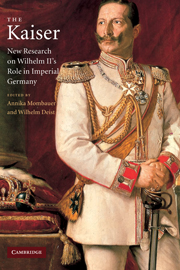Book contents
- Frontmatter
- Contents
- Notes on contributors
- Acknowledgements
- List of abbreviations
- Introduction
- Reflections on John Röhl: a Laudatio
- 1 Wilhelm II and ‘his’ navy, 1888–1918
- 2 Hollow-sounding jubilees: forms and effects of public self-display in Wilhelmine Germany
- 3 The Kaiser's elite? Wilhelm II and the Berlin administration, 1890–1914
- 4 Wilhelm, Waldersee, and the Boxer Rebellion
- 5 Dreams of a German Europe: Wilhelm II and the Treaty of Björkö of 1905
- 6 The uses of ‘friendship’. The ‘personal regime’ of Wilhelm II and Theodore Roosevelt, 1901–1909
- 7 Military diplomacy in a military monarchy? Wilhelm II's relations with the British service attachés in Berlin, 1903–1914
- 8 Wilhelm II as supreme warlord in the First World War
- 9 Germany's ‘last card’. Wilhelm II and the decision in favour of unrestricted submarine warfare in January 1917
- 10 Military culture, Wilhelm II, and the end of the monarchy in the First World War
- 11 Rathenau, Wilhelm II, and the perception of Wilhelminismus
- 12 Structure and agency in Wilhelmine Germany: the history of the German Empire – past, present, and future
- Index
8 - Wilhelm II as supreme warlord in the First World War
Published online by Cambridge University Press: 24 July 2009
- Frontmatter
- Contents
- Notes on contributors
- Acknowledgements
- List of abbreviations
- Introduction
- Reflections on John Röhl: a Laudatio
- 1 Wilhelm II and ‘his’ navy, 1888–1918
- 2 Hollow-sounding jubilees: forms and effects of public self-display in Wilhelmine Germany
- 3 The Kaiser's elite? Wilhelm II and the Berlin administration, 1890–1914
- 4 Wilhelm, Waldersee, and the Boxer Rebellion
- 5 Dreams of a German Europe: Wilhelm II and the Treaty of Björkö of 1905
- 6 The uses of ‘friendship’. The ‘personal regime’ of Wilhelm II and Theodore Roosevelt, 1901–1909
- 7 Military diplomacy in a military monarchy? Wilhelm II's relations with the British service attachés in Berlin, 1903–1914
- 8 Wilhelm II as supreme warlord in the First World War
- 9 Germany's ‘last card’. Wilhelm II and the decision in favour of unrestricted submarine warfare in January 1917
- 10 Military culture, Wilhelm II, and the end of the monarchy in the First World War
- 11 Rathenau, Wilhelm II, and the perception of Wilhelminismus
- 12 Structure and agency in Wilhelmine Germany: the history of the German Empire – past, present, and future
- Index
Summary
WILHELM II: A SHADOW KAISER?
‘The Beast of Berlin’ was the name of an American film, made in 1918, which depicted Wilhelm II as a militaristic monster. This title reflected public opinion among the Allied Powers at the end of the First World War. ‘Hang the Kaiser!’ was the motto which won Lloyd George the election of 1918. And in Article 227 of the Versailles Treaty the victorious powers in the First World War called for Wilhelm II to be publicly indicted for the ‘most serious infringement of international moral law’. He was never brought to trial, only because the Netherlands, where the ex-Kaiser had fled, refused to extradite him.
The desire to punish the Kaiser for the war was based on the assumption that, as the highest-ranking person in charge of German policy, he was partly to blame for the war, and responsible for its bloody course. This assumption did not seem to be unjustified. After all, Wilhelm II had been astonishing and irritating his contemporaries with his autocratic and militaristic pronouncements for decades. His unpredictable volatility, in particular, raised doubts. Bismarck once disapprovingly remarked that Wilhelm II had an opinion about everything, but that it was a different one every day. And indeed, the Kaiser was known to the people around him as Wetterhahn (weathercock) or Ballon (balloon), who always blew with the prevailing wind.
- Type
- Chapter
- Information
- The KaiserNew Research on Wilhelm II's Role in Imperial Germany, pp. 195 - 216Publisher: Cambridge University PressPrint publication year: 2003
- 1
- Cited by



